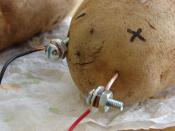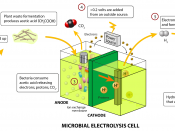An Investigation into the effect of concentration of an electrolyte upon the amount of energy that is able to pass through it.
Aim: To prove that the concentration of an electrolyte affects the current that can be passed through it
Apparatus: Electrodes,
Beaker,
Lab Pack
Measuring Cylinders
Wires
Materials: Hydrochloric acid (HCl),
Water
Diagram:
Prediction: I believe that as the concentration increases, so does the amount of current passed through the electrolyte. I believe that the graph that I will get from the experiment will be this. I believe this as the experiment is reliant upon the surface area of the electrode at any one given time. I therefore believe that, there will be a peak to the graph as the surface area of the electrodes slowly reduces because of the numbers of ions 'swarming' towards it.
Scientific Knowledge:
Electrolysis
All ionic compounds can be decomposed by using electricity by a process called electrolysis.
But, for all to decompose, they have to be in a molten state. During the decomposition, the compound breaks to form ions. These ions are then attracted to either the cathode ( the negative electrode) or the anode (the positive electrode) depending on their charges. Metals and Hydrogen always form positive ions, and the non-metal will always form a negative ion. The electrodes are made of an inert material such as graphite, (unless purifying or electroplating a metal), this is so that they remain there throughout the experiment. The molten substance that is electrolysed is called the electrolyte.
Examples:
Hydrochloric Acid hydrogen gas and chlorine gas
2HCl(L) H2 + Cl2
At the cathode:
2H+ + 2e- H2
At the anode:
The electrolysis of solutions
If a salt is dissolved in water (aqueous), the ions are free to move, and so the...



Hmmm
not bad for a lab report, but lab reports dont come in too much handy in a eassy distribution site
5 out of 5 people found this comment useful.